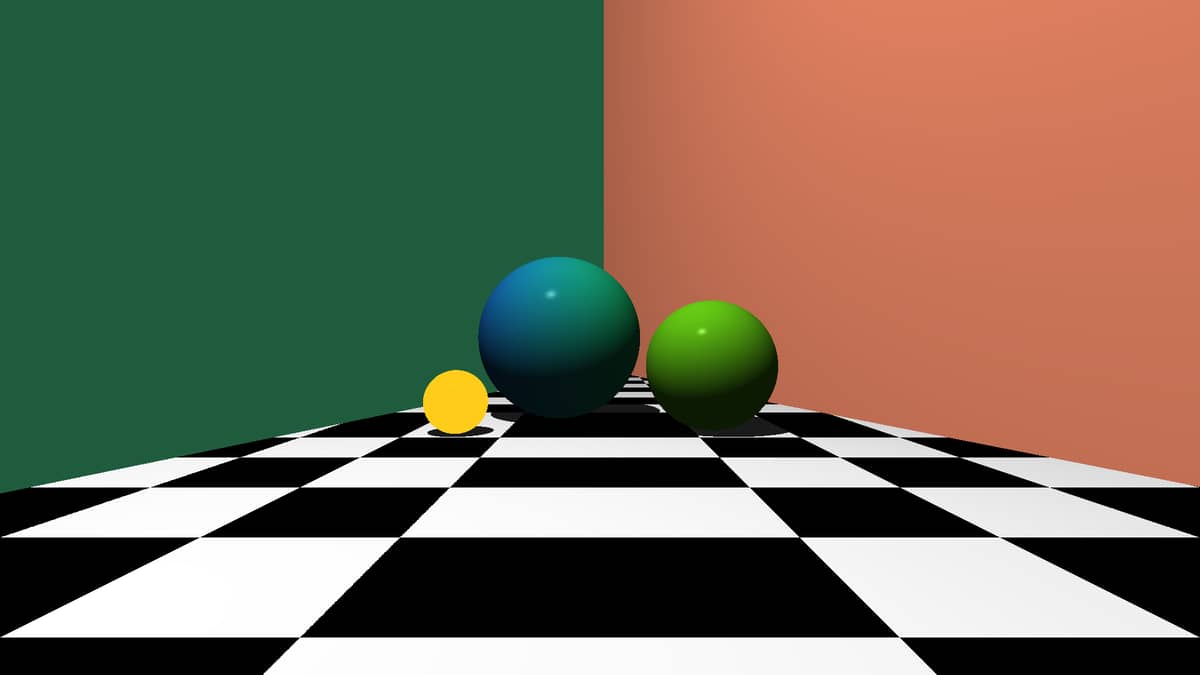Hello,
first of all, thanks for the book, it helped me a lot.
I just encountered an issue with the refraction, i have implemented the tests and made them all pass, but when i want to render with refraction, the render is not really what i think it should be.
Here some picture :
the yellow sphere have a transparancy of 1 and a refractive_index of 1
here is my main code :
int main(void)
{
t_world world = world_create();
world.lights_count = 1;
world.objs_count = 6;
world.objs = malloc(sizeof(t_shape) * world.objs_count);
world.lights = malloc(sizeof(t_plight) * world.lights_count);
world.objs[0] = sphere(0);
world.objs[0].material.pat = pattern(GRADIENT, color(0.1, 0.5, 1), color(0.1, 1, 0.5));
pattern_set_transform(&world.objs[0].material.pat, matrix_mult(matrix_translation(-1, 0, 0), matrix_scaling(2, 2, 2)));
world.objs[0].material.color = color(0.1, 1, 0.5);
world.objs[0].material.diffuse = 0.7;
world.objs[0].material.specular = 0.3;
shape_set_matrix(world.objs, matrix_translation(-0.5, 1, 0.5));
world.objs[1] = sphere(1);
world.objs[1].material.color = color(0.5, 1, 0.1);
world.objs[1].material.diffuse = 0.7;
world.objs[1].material.specular = 0.3;
shape_set_matrix(world.objs + 1, matrix_mult(matrix_translation(1.2, 0.7, -0.5), matrix_scaling(0.7, 0.7, 0.7)));
world.objs[2] = sphere(2);
world.objs[2].material.transparency = 1;
world.objs[2].material.refractive_index = 1;
world.objs[2].material.color = color(1, 0.8, 0.1);
world.objs[2].material.diffuse = 0.7;
world.objs[2].material.specular = 0.3;
shape_set_matrix(world.objs + 2, matrix_mult(matrix_translation(-1.5, 0.33, -0.75), matrix_scaling(0.33, 0.33, 0.33)));
world.objs[3] = plane(3);
world.objs[3].material.pat = pattern(CHECKER, color(0, 0, 0), color(1, 1, 1));
world.objs[3].material.color = color(0, 0, 0);
world.objs[4] = plane(4);
world.objs[4].material.color = color(0.7, 0.4, 0.3);
world.objs[4].material.ambient = 0.6;
shape_set_matrix(world.objs + 4, matrix_mult(matrix_translation(0, 0, 12), matrix_mult(matrix_y_rotation(-(M_PI/12)), matrix_z_rotation(M_PI/2))));
world.objs[5] = plane(5);
world.objs[5].material.color = color(0.2, 0.6, 0.4);
world.objs[5].material.ambient = 0.6;
shape_set_matrix(world.objs + 5, matrix_mult(matrix_translation(-3, 0, 0), matrix_mult(matrix_y_rotation(M_PI/12), matrix_z_rotation(M_PI/2))));
world.lights[0] = point_light(point(-2, 10, -5), color(1, 1, 1));
t_camera cam = camera(1920, 1080, M_PI / 2);
camera_set_transform(&cam, view_transform(point(0, 1, -7), point(0, 1, 0), vector(0, 1, 0)));
t_canva image = render(cam, world);
if (!image.canva)
return (1);
(void)image;
char *ppm = canva_to_ppm(image);
write_file("render/test.ppm", ppm);
free(ppm);
free(image.canva);
free(world.objs);
free(world.lights);
}
Here my refracted_color function :
t_color refracted_color(t_world world, t_precomp comps, size_t remaining)
{
double n_ratio;
double cos_i;
double cos_t;
double sin2_t;
t_color c;
if (comps.obj->material.transparency == 0 || remaining == 0)
return (color(0, 0, 0));
n_ratio = comps.n1 / comps.n2;
cos_i = dot(comps.eyev, comps.normalv);
sin2_t = n_ratio * n_ratio * (1 - cos_i * cos_i);
if (sin2_t > 1)
return (color(0, 0, 0));
cos_t = sqrt(1.0 - sin2_t);
color_at(world, ray(comps.under_point, tuple_substract(tuple_scalar_mult
(comps.normalv, n_ratio * cos_i - cos_t), tuple_scalar_mult
(comps.eyev, n_ratio))), &c, remaining - 1);
return (color_scalar_mult(c, comps.obj->material.transparency));
}
I don’t really know how to get the refraction worked, if something can help please !

